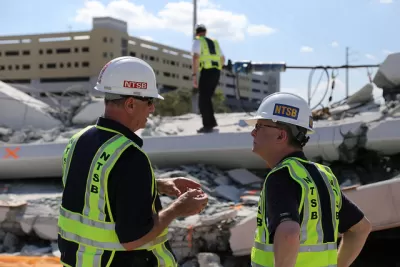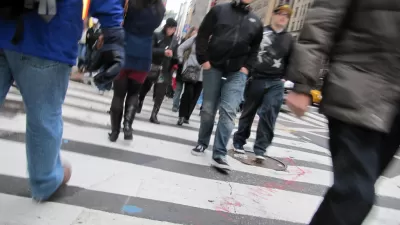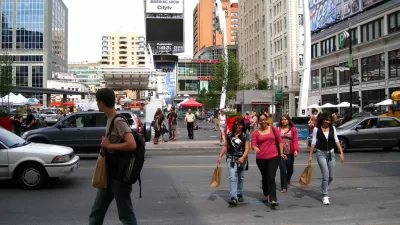The National Transportation Safety Board is looking for the cause of the horrific collapse of the Florida International University pedestrian bridge collapse on March 15, killing six. people. Angie Schmitt questions why a ped span was needed at all.

The 850-ton steel and concrete span was the centerpiece of the FIU-City of Sweetwater UniversityCity Bridge project, spanning the eight lanes of Tamiami Trail (said to be a contraction of the phrase "Tampa to Miami") connecting Florida International University in University Park to Sweetwater where over 4,000 FIU students live.
Last August, FIU freshman Alexis Dale, was crossing the roadway, known locally as Southwest Eighth Street, when she was fatally hit by a motor vehicle. That tragic incident spurred the need for a pedestrian bridge, reports ABC News.
"You can expect most coverage to treat the [bridge collapse] as a story about construction failure," writes Angie Schmitt for Streetsblog USA on Friday, the day after the tragic collapse. "But the situation begs reporters to step back and consider a broader perspective."
Indeed, Planetizen coverage (posted Sunday) highlighted the use of accelerated bridge construction (ABC) techniques, what the Miami Herald called "instant bridge," with cranes dropping the span into place on Saturday, March 10. Media coverage now centers on the discovery of a crack in the structure, and why traffic on the busy thoroughfare wasn't halted while engineers were undergoing stress testing and cable tightening.
Why no alternative to bridge construction?
Did the process to apply for federal funding require that an alternatives analysis be performed? The $14.2 million bridge, connecting plazas and walkways is part of a $19.4 million Transportation Investment Generating Economic Recovery (TIGER) grant from the U.S. Department of Transportation, according to FIU.
"The university, the city of Miami [sic], or the state DOT [see their fact sheet (pdf) on the bridge failure] could have tried to make the whole street safer," writes Schmitt.
Southwest 8th Street is clearly too wide, and there are a number of ways to narrow crossing distances and reduce dangerous speeding, like adding concrete median islands, or replacing car lanes with wider sidewalks...Instead, the state of Florida chose a solution that would not disrupt the configuration for motorized traffic in any way: a pedestrian bridge.
While the bridge did indeed present a safe alternative to crossing the roadway at grade, it also "prioritized fast-moving cars," notes Schmitt, as did the ABC method. With no pedestrians crossing the street, no need for those long pedestrian count-down signals.
Separating pedestrians from motor vehicle traffic rather than integrating the two modes fits in well with the university's transportation paradigm, observes Schmitt.
The FIU campus is designed around the movement and storage of cars and is dominated by parking [jpg]. Locals tell us that there is really no transit access to the university except for a couple of out-of-the-way bus stops.
In 2015, the Miami-Dade Metropolitan Planning Organization released a study [pdf] of the 8th Street corridor. Though it mentioned the FIU campus, the report focuses almost exclusively on speeding up car traffic, not pedestrian safety. The planning agency rejected the addition of bus lanes and instead elected to make the road more like a highway, with grade separations at two intersections.
Schmitt concludes by writing that "[a]n effective approach to traffic safety would consider the dangerous conditions for pedestrians that led to the construction of the bridge in the first place. If we don’t think critically about these systemic risks, our transportation networks will keep on failing at public safety."
As of Sunday, the death toll stands at six. All victims have been recovered.
Hat tip to Len Conly via Sierra Club transportation forum.
FULL STORY: The Florida International Bridge Collapse Is About So Much More Than a Failed Structure

Alabama: Trump Terminates Settlements for Black Communities Harmed By Raw Sewage
Trump deemed the landmark civil rights agreement “illegal DEI and environmental justice policy.”

Planetizen Federal Action Tracker
A weekly monitor of how Trump’s orders and actions are impacting planners and planning in America.

The 120 Year Old Tiny Home Villages That Sheltered San Francisco’s Earthquake Refugees
More than a century ago, San Francisco mobilized to house thousands of residents displaced by the 1906 earthquake. Could their strategy offer a model for the present?

In Both Crashes and Crime, Public Transportation is Far Safer than Driving
Contrary to popular assumptions, public transportation has far lower crash and crime rates than automobile travel. For safer communities, improve and encourage transit travel.

Report: Zoning Reforms Should Complement Nashville’s Ambitious Transit Plan
Without reform, restrictive zoning codes will limit the impact of the city’s planned transit expansion and could exclude some of the residents who depend on transit the most.

Judge Orders Release of Frozen IRA, IIJA Funding
The decision is a victory for environmental groups who charged that freezing funds for critical infrastructure and disaster response programs caused “real and irreparable harm” to communities.
Urban Design for Planners 1: Software Tools
This six-course series explores essential urban design concepts using open source software and equips planners with the tools they need to participate fully in the urban design process.
Planning for Universal Design
Learn the tools for implementing Universal Design in planning regulations.
Clanton & Associates, Inc.
Jessamine County Fiscal Court
Institute for Housing and Urban Development Studies (IHS)
City of Grandview
Harvard GSD Executive Education
Toledo-Lucas County Plan Commissions
Salt Lake City
NYU Wagner Graduate School of Public Service




























